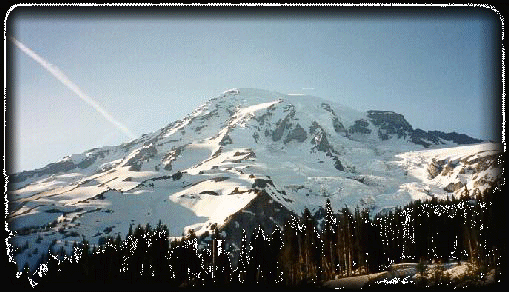Magazine Source - SIRS
We looked to SIRS for our extra source, a magazine listing, and we found a very interesting article worth including on this site. This article is listed below.
Picture of Mount Rainier
This article was in fact not about volcanoes erupting, except in the first section, but the danger of living alongside them (even while not showing signs of extreme activity). It focuses mainly on Mt. Rainier and tells about the possible dangers without actually going into very much factual information. To summerize this article, we had to summerize a lot of quotes, so we did the best we could and you'll have to bear with us as we delve into the article from the Smithsonian called "Geologists worry about dangers of living 'under the volcano'".
Mt. Rainier has erupted numerous times in the past (most recently 150 years ago) and the author of this article finds it amazing, if not disturbing, that people live so very near it. Geologists say that Rainier could erupt again in as few as 10 years, or as many as 10,000 years, but that it definately will erupt again. Twelve remote-sensing devices are monitering Rainier 24 hours a day. Steve Malone, a geophysicist who oversees the seismology lab says that, although providing information on the activity of the volcano, they are mainly for the media and that they "give TV crews something to point their cameras at whenever there's an earthquake. There at the lab, says Malone, they occasionally look at the readings, but usually rely on a sophisticated computer system (so it must be an IBM system :p ). He also says that the big St. Helens eruption in 1980 was proceeded by a series of minor earthquakes; A result of the magma moving up through the "throat" of the volcano. In truth though, Malone doesn't think that Rainier will go up in a St. Helens like eruption. He says that the most damage will be caused by a little known lahars or debris flows consisting of mud, rock, and ice surging from the top of the volcano at high speeds.
There are towns that are actually built upon old lahars. One town, called Armero has been destroyed at least once. In fact, more than 100,000 people live in homes built on debris from lahars. Mr. Kevin Scott, a senior geologist at the USGS's Cascade volcano observatory says that (judging from past mudflows) the recurrence interval for major lahars is between 500 and 1,000 years. Scott puts Rainier in a class of it's own when it comes to risk of human lives and property.
Mt. Rainier is becoming increasingly unstable as years go by because it is literally "stewing in it's own juices". In other words, the heat that Mt. Rainier puts off at the mouth melts the glaciers on top of it, making geothermal aquafers. This constantly circulates through the mountain, but sometimes it will combine with sulfuric gasses and produce acids that are actually eroding Rainier from the inside out. Some geologists have even discovered some bands of weak, highly altered rock that penetrates the mountain. We believe that you can understand the consequences of such an action.
As you can see, Mt. Rainier could easily be as much of a danger not erupting as it could if it did.
Copyright 1998 Leatherman and Hofker Enterprises